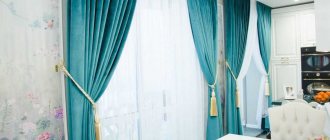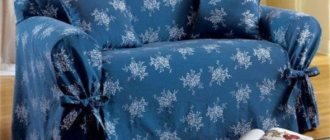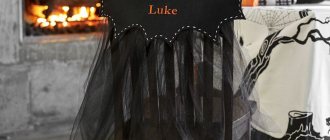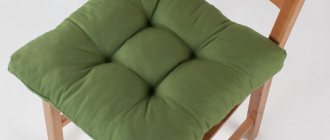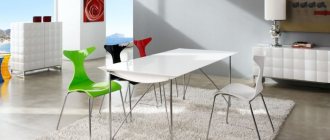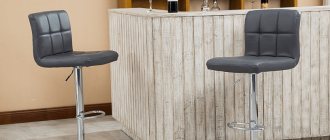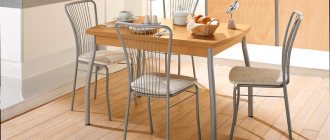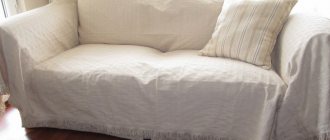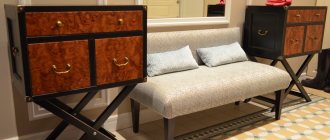Every needlewoman has a desire to beautifully and effectively transform the design of a room and its interior, but not every one of them wants to make any drastic changes or resort to large-scale renovations. One of the simplest, but at the same time effective ways to logically complete the interior or emphasize it is to sew original covers for chairs and stools.
Such design elements can not only please the eye and give old furniture a new life, but also protect it from various types of pollution and pests. To discover this practice, it is recommended that you familiarize yourself with it in full. This material will tell you how to sew a cover for a chair, an attachment for a stool, patterns for chair covers, what fabric to choose for this, and what features the sewing process involves.
The cover can bring back the popularity of an old chair
Benefits of making your own chair covers
Firstly, the covers, which were created by hand, not only meet all the style preferences of the hostess, but are also made conscientiously, from high-quality material. Chairs with backrests and stools in protective covers do not lose any of their practical properties, but acquire new characteristics: beauty, elegance. Removable upholstery protects furniture from premature aging and abrasion.
Simple cover for kitchen chairs
During the sewing process, you can determine how well a particular fabric is suitable for the seat, how it sits and stays on it. It is impossible to check this when purchasing store products.
Important! If the cover is sewn by hand, it will be of high quality and will cost a minimum of money or almost free if fabrics from old things were used for sewing.
Homemade stool covers
The advantages of making “upholstery” with your own hands are obvious:
- The seats will be original and will fit perfectly into the interior of the room if certain requirements are met;
- Furniture that has been improved through “cladding” will become more comfortable and will “live” longer due to its protection;
- Manufacturing will take little material and money, and the appearance of the furniture will change dramatically;
- Removable covers can be easily removed and washed if they get dirty.
Covers not only protect furniture, but also complement the interior
Decoration options
The style of the interior in which the chair will stand dictates the methods of decoration. Laconic minimalism or modernism do not tolerate overload, but will accept a combination of fabrics by color or texture, discreet details: pockets, folds. To decorate cases in a classic interior, the following are suitable:
- long frills;
- edgings emphasizing the clarity of the form;
- thin golden or woven braid;
- imitation of antique lace.
This trend is generally characterized by ceremonial decor and regular geometric shapes.
Rustic style, country and Provence suggest natural fabrics and very cozy finishes:
- frills, ruffles;
- crocheted lace;
- braid with ornament;
- lacing.
Homemade and chemical compositions for cleaning chair stains, stages of work
In banquet halls, chair covers with backrests are decorated according to the general style of the room. Beads, satin ribbons, rhinestones, and brooches are used for decoration. Artificial or fresh flowers will also come in handy.
Such “clothing” for furniture will protect new chairs and stools from dust and damage, and will give old ones another chance. In addition, hand-made chair covers will add comfort and beauty to your beloved home. And if you create several sets, then with their help you can update the interior every season.
How to choose a style
Chair decoration is classified according to several factors: style, which includes the shape and function of the products, as well as the material used to make them. The latter will be discussed in detail in the next section.
Depending on the shape of the products, they are divided into several categories:
- Solid ones that fully cover the furniture from external influences. They cover not only the seat, but also the back and legs. They have a strong fixation, which helps to radically change the design of furniture and hide its shortcomings;
You might be interested in this. Patterns for dresses and kimono robe: sewing with your own hands
A one-piece cape, which has already become a traditional option for chairs with a backrest
- Separate, which will include separated covers for the back and seat. Due to this, specific advantages appear: ease of care, since you can easily remove part of the decor and wash it, practicality.
Separate elements are practical and original
- Only sitting. It only covers the seat and the lower part of the chairs. This option is the most practical and requires little time and economic investment.
The cover over the seat reliably protects it from abrasion.
The choice of style also depends on the purpose and functions of the covers, based on which they are divided into:
- Everyday accessories used every day. It is worth remembering that such covers must be washed more often due to constant load. To do this, when choosing a material for them, they rely on dense and highly resistant fabric that is easy to clean;
A simple cape for everyday use
- Solemn. They are intended for festive events and have the main task of decorating the design and causing a “wow” effect among guests, focusing attention on the table. They differ from ordinary ones in that they are usually made from expensive types of fabrics with various decorations in the form of bows, frills, ribbons and draperies.
Formal covers effectively focus attention on yourself and the table
Style selection
Before you start choosing a style for covers, you should understand which forms of this attractive product are most actively used. This is important because it gives answers to questions about choosing fabric, choosing its pattern, color, texture and texture.
This form is the most difficult to produce.
Experts divide chair covers into everyday and holiday ones. It’s clear with the first ones, they don’t look too bright, not too presentable, they are intended for intensive use at a time when no one pays much attention to either style or choice of fabric. Let's take these circumstances into account when preparing for the manufacture of covers.
Another chair covers are festive ones. By definition, such devices can only be made from expensive, beautiful, durable fabric designed for long-term use in adverse conditions.
As a rule, such covers are made from expensive materials.
The styles of chair covers that will be preferred are determined both by the tastes of customers, room owners, and by previously applied style solutions in the decoration of walls, furniture, and other important objects.
The classic style, although it looks somewhat old-fashioned and heavy, remains the most universal. A case made in this style is suitable for all design options and organically fits into compositions of great complexity.
Luxury covers add special chic and comfort to the room.
Provence style covers are lightness, a lot of light, peace and tranquility. Suitable for melancholic people who live secluded, but not lonely.
And there are also modern and high-tech styles. In general, in order to choose a design solution for cases, you need to think carefully. You should weigh up the pros and cons, get the consent of all interested people and realistically assess your financial capabilities.
Choosing fabric for sewing
Sewing can be done from a variety of materials. It all depends on the final purpose of the cover. For daily use you need a practical and inexpensive fabric, and for the holidays you need a beautiful and elegant one. In addition, they take into account the room in which the chairs are located, its purpose and its own interior.
Important! For everyday use, you should choose a wear-resistant material that can be removed and washed or knocked out at any time. One of the criteria is also the absence of electrification and absorption of contaminants. Some of the best fabrics for sewing are considered to be cotton, microfiber, linen or silk.
Stylish case in light colors
Cotton fabrics
Among them, the priority is satin, calico, denim or twill. Their key advantage is that they hold their shape well, do not cause allergies in sensitive people and are machine washable. Cotton fabrics are inexpensive and come in a variety of shades, colors and patterns. They also have disadvantages: rapid fading and getting wet.
Cotton covers
Linen fabrics
These include matting, linen itself and canvas. They are environmentally friendly, highly durable, dirt-repellent and can be subjected to intensive machine washing and intensive use. Also, linen does not absorb dirt well, it is hypoallergenic and easy to care for. Rough, minimally processed linen fabrics are ideal for everyday slipcovering. The disadvantages are: difficulty in cleaning and ironing, rough texture. Linen covers are suitable for everyday use in country or ethnic style rooms.
Linen fabric looks practical but beautiful
Flock and microfiber
These materials are new generation materials. Their main advantages were:
- Wear resistance;
- Attractiveness;
- No creasing;
- No deformation when washing.
You might be interested in this: The procedure for sewing a one-piece swimsuit for an overweight woman on your own
Important! Despite this, microfiber and flock cannot be subjected to heat treatment: dry on a radiator and iron. This is not necessary if there is no creasing.
Microfiber chair cover
Silk
Silk fabrics include: brocade, satin, crepe-satin. Their advantages are that they are durable, noble and resilient. Silk fabrics make it possible to create spectacular folds and draperies. There are also disadvantages: high price, demanding care and washing, careful ironing. Such canvases are suitable for creating holiday covers in classical and neoclassical, Indian and Arabic styles.
Silk covers can emphasize the solemnity of the event
Materials and tools
The fabric for chair covers is selected depending on the purpose of the furniture. Inexpensive textiles that are easy to wash and iron are suitable for the kitchen:
- Cotton: calico, teak, satin. It is advisable to duplicate thin material with double thread or a layer of non-woven fabric, so it will hold its shape better.
- Linen looks great due to its texture, but is difficult to iron.
- Fabrics containing synthetic fibers: polycotton, gabardine - wrinkle less and are easy to wash.
The procedure for making a chair with your own hands, taking into account the features of the model
If we talk about new products, then you can pay attention to supplex - elastic knitwear. It easily adapts to shape, does not accumulate static tension, and dries quickly. In addition, this material comes in bright colors, so suitable for the kitchen.
In the living room, chair covers are made from fabric that matches the rest of the textiles:
- jacquard, tweed, velor, flock - they have a rich texture and hold their shape well;
- corduroy and denim are appropriate in a modern interior or a teenager’s room.
Decorating halls for a wedding or other celebration involves elegant, well-draped fabrics. Flashy but inexpensive materials are suitable, since the case will be used for several hours. Optimal options:
- satin and silk are slippery, shiny, flowing fabrics that require lining and reliable fastenings;
- crepe-satin, gabardine, knitwear - their texture is more restrained and allows you to create beautiful frills and draperies;
- taffeta, veil - used to create airy flounces and lush bows.
Moms take different paths when choosing fabric for a highchair cover. Those who need practicality take waterproof materials, others value the baby’s comfort, and still others find a universal but expensive option. Each of them has both advantages and disadvantages:
- Eco-leather - oilcloth-based fabrics are easy to clean and are not afraid of spilled milk. But they are not hygroscopic - in the hot season the child will sweat.
- Velor and knitwear are soft - pleasant to the touch, but they will get dirty, and the cover will have to be washed often.
- NANOtex is a material with microparticles of silver with a water-repellent effect, breathable, does not cause allergies, spilled liquid can simply be blotted with a napkin.
Before cutting, the fabric must be wet-heat treated so that the finished product does not shrink. This is especially important for linen and cotton.
Additional materials that may be needed when sewing:
- lining fabric;
- padding polyester or padding polyester;
- fastenings and fasteners: elastic band, Velcro tape, buttons or zippers;
- braid, fringe, lace and other decorations.
In addition to the sewing machine, you will need: a measuring tape, a marker, scissors, pins and thread.
NANOtex
Velveteen
Denim
Jacquard
Linen
Cotton
How to take measurements and make a pattern?
The first thing you need to do when sewing is to take measurements of the furniture. The pattern directly depends on the design and dimensions of the chair or stool. To take measurements, take material that holds its shape well and cover the chair with it, securing everything with pins. At this stage, they take into account: how much the legs of the chair will be covered, whether there will be fasteners on the back, and so on.
Luxury and functionality combine in brocade
Measurements can also be taken using tracing paper. To do this, a layer of paper is first applied to the seat and secured with pins. After this, a stroke is made along the contour. For allowances, add one and a half centimeters on each side. Subsequently, the parts are cut out. The back is measured in the same way if sewing is done for a chair.
For the front of the cape, measure the length of the legs and the width of the front edge of the product. After this, a given rectangle is drawn on tracing paper, adding 5 cm at the bottom and 10 cm at the sides. To all this add a 1.5 cm seam allowance at the top edge.
Practical and stylish capes
Patterns for the sides of the “skirt” are made in the same way. Add 15 cm to the edge adjacent to the outer part of the back. The pattern is made in several copies. Measuring the outer part of the backrest is done as follows:
- A large sheet of tracing paper is applied to it at the top of the backrest;
- The edges of the outer side are marked;
- Lines are drawn along the legs to the floor;
- Add 5 mi at the bottom and 1.5 cm for the seam allowance.
Translucent cape on the back
Important! Centers are marked at the top and bottom of the patterns, along which the fabric is then folded and cut into two even parts.
How to attach a seat to a chair?
A simple way to attach a knitted seat to a stool is to knit a skirt perpendicular to the seat part. To do this, knit 10-15 cm along the contour with a simple knitting stitch with an equal number of stitches in each row. This method is suitable for a seat of any shape.
If the chair has a back, knit a flap that will fall between its uprights. On the sides of the skirt, elongated parts are made that can be folded at the corners to the back side and fastened to the flap. If the back is solid and the described method is not suitable, then the sides are extended enough to fasten or tie their ends behind the vertical part.
Step-by-step instructions on how to sew a cover for a chair with a backrest
You can order tailoring from purchased fabric from a craftsman, but it is much more profitable and enjoyable to do it yourself. The only caveat: all measurements must be accurate and take into account seam allowances and fabric shrinkage when washing. For this, one or one and a half centimeters should be enough.
You might be interested in How to make a practical organizer yourself
Instructions for sewing a simple product
To get started, you need to prepare all the necessary materials and tools:
- Threads and needles;
- Sewing machine;
- Adhesive tapes;
- Scissors and awl.
Taking measurements from a standard chair
Step-by-step manufacturing instructions are as follows:
- Make a pattern on tracing paper or film that will fit well on the furniture to take all measurements;
- Cut out a seat from soft synthetic padding and make allowances of 1 cm at the edges and 3 cm at the back;
- Attach the padding polyester to the seat and measure out the recesses for the legs at the back. Cut notches along the contour;
- Determine the height of the cover and, leaving the bottom of the furniture open, measure the sides and back wall of the chair;
Case decorated with bows
- Transfer the pattern to the selected material and cut it out, not forgetting to leave allowances for seams and shrinkage;
- Round the corners on the sides for a better “seat” of the cover;
- Sew all the parts together using a sewing machine. Make notches on the rounded edges to avoid wrinkles in the fabric;
- Sew decorative elements in the form of braid or beads around the perimeter of the seat;
- Try on a chair cover;
Case for children, decorated with a flower
Where can it be used?
Step-by-step instructions for making chair covers will help solve the problem. If you sew a cover yourself, you can make the most suitable option for implementing any design solution or so that the product fits well into the design style existing in a particular room.
Ordering a custom-tailored cover is more convenient than finding ready-made capes that match the style, color and size.
Chair covers are most actively used in the design of living rooms, kitchens and other rooms in an apartment or private house. Their presence there is most necessary, since people are constantly present in these places.
The presence of people means that it is necessary to take care of the hygienic properties of the material from which the cover is made and its harmlessness to health, especially of children.
Universal models fit different chairs.
Another place where chair covers are used is in office spaces. This is a place where intensive work takes place, and where all things, including furniture, capes and covers, become unusable very quickly. Naturally, they urgently need to be replaced or repaired. And here step-by-step instructions will come in handy, allowing you to create a new original case at minimal cost.
These covers are especially ideal for chairs without armrests.
Chairs with covers are used in schools and other educational institutions. It’s easy to guess how quickly they break down, even if they are made of the most durable fabric. For places where children study, it is necessary to make especially durable covers that can withstand the frantic pressure of children's energy.
Anyone who has watched the movie “Orient Express”, or anything similar about railway transport, has noticed how rich, luxurious and beautiful the covers are on the backs of expensive seats. Not every master can make such a product. But if you try hard and study for a while, everyone can do it.
Due to the strength of the fabric, they protect the chairs from external influences.
Beautiful and expensive cases are used by heads of state, presidents of companies and corporations, and other people whose wallet allows such luxury. But the point is not in the cost of the fabric, but in the imagination and inspiration of the master. Even from ordinary chintz you can make a work of art.
The best cases, like the works of great masters, are always made for themselves and their loved ones. This usually requires patience, desire, imagination with inspiration, and the ability to find the required materials of the highest quality from underground.
Solid or thick covers completely cover the chair - both the back and the seat.
But it’s time to proceed to the next stage of making the case - choosing the style in which the work will be done. Certainty in this matter is especially important, since the style will be used in the decoration of the entire house or apartment.
Features of covers for high chairs
If the cover is made for a children's high chair, then the most correct thing would be to make it from hypoallergenic types of cotton fabric that are durable and wear-resistant. This material is breathable and easy to wash. The fabric itself is quite cheap and it wouldn’t be a shame to throw away such a cover if it gets damaged by a little tomboy.
It is best to put a water-repellent cover on the high chair that will wash without problems. Since all furniture has its own design, you will have to take all measurements individually on a chair or on a standard cover.
Children's case in the form of a kitchen game
Important! If the kit included a standard case, then you should carefully examine it and understand where the seams are and what kind of design it has.
The general sewing method is simple:
- Fasten the main fabric and the gasket;
- Place them face to face;
- Sew along the edges, leaving 20 cm unsewn on the side to turn the product inside out;
- Turn out the “upholstery” and straighten it;
Stool seats wear out quickly without a cover
- Fold up the unstitched side and stitch it in any way;
- Mark the places where seat belts should be located if necessary;
- Decorate the product with bows, ruffles, ribbons or thermal appliqués.
Mattress for high chair
DIY stool covers
After taking measurements, selecting fabric and filling, you can begin the sewing process.
Upholstering square seats
Before sewing a cover for a stool with an elastic band, you need to measure the surface of the product and transfer the data to cardboard. It should be applied to the filler and a piece of suitable size should be cut out of it. A cardboard element is applied to the fabric in the same way, but a piece is cut out with a margin of 7–8 cm (depending on the thickness of the filler). When all the parts are prepared, you can begin the process of connecting the furniture cape.
Round cover for chairs
How to sew a cover for a stool with your own hands - instructions:
- padding polyester and lining fabric are connected and stitched around the perimeter;
- a groove is left at the top for stitching the hem;
- the actions are repeated with the overlapping segment;
- the lower part of the product, on which the filler is fixed, is applied to the upper;
- the parts are combined using a hidden seam;
- an elastic band is pulled into the hemmed lapel. For these purposes, you can use a pin;
- The seams are machined and smoothed using steam treatment.
After this, the accessory can be tried on a stool. If the product sits loosely, it can be sewn in at the corners. When the cape matches the size of the furniture, it can be decorated with various elements: lurex, beads, satin ribbons.
Round form
How to decorate round seats
Before sewing a cover on a stool with your own hands, you will need to lay out the prepared material on the floor, straighten it (preferably with an iron) and attach the upper part of the stool to its surface, circle it with a piece of soap or chalk. The second circle is drawn according to the same pattern, but with a 10 cm indentation from the edges of the first. The diameter of the second part should be 5–6 cm larger (specific numbers depend on the thickness of the selected filler).
Square case
What to do next, master class:
- according to the planned pattern, make a pattern from the filler;
- attach the padding polyester to a larger piece of fabric;
- sweep the workpiece around the edges;
- bend the ends of the large circle so that they fit tightly around the soft filler;
- attach a round piece of smaller diameter to the workpiece;
- sew the elements together using a hidden seam, not forgetting to leave room for the elastic;
- make a bend for threading the elastic;
- thread it through with a pin;
- Carefully sew the seams using a machine.
Important! Now you can attach the accessory to the furniture. If its size is suitable, you should start decorating the cover.
Homemade covers for stools
Decorating the product
When using colorful or patterned fabric, you can do without additional decoration of the resulting products. However, if a plain fabric was used in the process, the artist can refresh the accessory a little and make it more interesting. Most often, experts use the following decorative elements to decorate such a necessary piece of furniture:
- lightning;
- bows;
- decorative ties;
- ruffles and flounces;
- satin ribbons;
- brooches, artificial flowers;
- rhinestones, sequins, lurex;
- beads.
Decorating elements
When choosing decorative elements, you need to take into account that the cover will have to be washed periodically, so it is better to focus on durable and moisture-resistant elements. In such cases, satin ribbons, bows, and ruffles are suitable. Sequins and rhinestones may fall off or lose their attractive appearance if washed regularly.
It is also worth considering that some decorative elements are not entirely comfortable for sitting. This applies to brooches, flounces, bows. For everyday use, it is better to use more practical parts (or abandon them altogether).
Important! Decorative elements can be glued with strong fabric glue (ordinary glue will not work in this case) or sewn on using a thread and a needle. Beads for decorating capes
Beads for decorating capes
Stool covers with soft filling are comfortable covers that help refresh outdated furniture and give it a more attractive appearance. Capes are made in various colors and decorative designs, which allows you to make an accessory for the interior of any style. In addition to external features, the product has a protective effect, preventing damage to the surface of the furniture.
Beautiful examples of cases
To expand the reader's creative potential, below are options for beautiful and elegant slipcovers that can restore any furniture to its former glory.
A colorful throwaway fabric can easily change the look of a simple bar stool.
Thus, the pattern for chair covers is not particularly complicated. Anyone, even a novice craftswoman, can do this and other stages of work. There are many classes of styles of covers; they are divided into formal and everyday. Based on this, the material for production, the presence of decorative elements and other things are selected.
Beautiful examples and options
There are an unusually large number of sites on the Internet that specialize in the production of furniture and accessories. You can usually find a large number of the best options for chair covers on their pages. The visitor will be amazed by the wealth of choice.
Chairs with covers are found everywhere. If you look around you carefully, you can see a lot of interesting things that are then used in your own practice of making covers.
Stylish chairs will advantageously complement other interior elements.
Practical bar stools with covers, products for a computer club, numerous solutions developed by specialists will be the best help in deciding which covers to make for your family with your own hands.
What is better to sew from?
Furniture protection is ordered from ateliers and sewing workshops. In addition, they sew chair covers with their own hands. First you need to decide what fabric the products will be made from.
The choice of material depends on factors such as the frequency of use of the chair, compliance with the design of the kitchen, and the intended purpose of the covering. Almost any materials are suitable for creating an accessory: from light decorative to natural rough ones. Covers are often made from the same fabric as curtains, tablecloths or other textiles in the kitchen.
It is recommended to pay special attention to the choice of fabric for capes for daily use. A good option for products would be a material made from a mixture of cotton and viscose. The fabric should not wrinkle much, fade, roll, leave snags, or “shrink” after washing.
If you prefer to do it yourself, you should not forget about sewing threads, which should match the color of the fabric.
Types of overlays
The design of the chairs on which the attachments will be attached is also important. The following types are distinguished:
- Stationary. Classic options on which the overlays are glued using glue, double-sided tape or a pre-treated adhesive surface.
- Adjustable. As a rule, plastic chairs are equipped with a special screw for adjusting the seat height.
- Mobile. Typical representatives are office and computer chairs. It is impossible to install treads on them, but you can purchase special rubber-coated wheels.
Chair protectors are also called toe caps or toe caps. Most often this is due to the special material used.
In the store you can find pads made of felt, rubber, silicone, plastic, cork, felt, Teflon and artificial leather.
Cork pads are ideal for stationary furniture. If a piece of furniture is often moved, then it is more advisable to use felt, felt and Teflon products. Chairs with metal legs can easily scratch not only parquet, but also tiles, so they must be shod with practical rubber or silicone pads.
The most popular options are:
- Self-adhesive protectors. They come in different shapes and sizes. Very easy to install.
- Rubber linings in the form of caps. Excellent prevention of slipping.
- Socks made of woven or knitted material. Most often they are made independently.
We recommend: A reminder for happy dishwasher owners: how to use the machine from loading to drying
You can buy protective fittings for chairs and stools at your local hardware store or make your own.
Manufacturing process: step-by-step instructions
The following example of the upholstery process concerns the design of seats for stools only. For chairs, everything will look slightly different due to design features.
The upholstery for them is most often made permanent, and a stapler and staples are used to secure the material.
Before starting work, use a piece of soap to draw textile patterns, with an overlap of approximately 10 cm on all sides. Carefully check all dimensions - the correct calculation of the seat circumference depends on this.
- Cut out a blank from fabric and filling. Do not forget that the fabric will cover the foam on the inside and outside.
How to make stool covers with your own hands
You can make a furniture cape from the following materials:
- gabardine. A soft fiber that has good strength. This fabric has a slight shine and is water-repellent. However, it has a significant drawback - during use the material slips a lot;
- crepe-satin. Soft and silky fiber with good wear resistance. The material practically does not wrinkle or stretch. Satin crepe looks elegant and is suitable for decorating stools in the living room;
- lycra. Dense synthetic fiber, characterized by wear resistance. Lycra is a budget-friendly and durable material;
- spandex. Polyurethane fiber, which is most often used for upholstering kitchen stools. The material does not absorb moisture or odors and can be easily cleaned with plain water.
Filling for covers
Furniture covers are also made from linen, brocade, and faux fur. It is recommended to make products from durable and moisture-resistant materials that respond well to high indoor humidity and periodic temperature changes.
Important! The best option is leather or spandex
Sewing a soft cover
After all the necessary parts from the base material, lining and filling have been measured and cut out, you can begin to connect the elements of the cover. The step-by-step scheme of actions involves combining padding polyester and lining fabric, stitching around the perimeter:
- A groove is left in the upper part of the cover for tucking and stitching the hem. The same must be done with the lap section.
- The lower part with the fixed filler is applied to the upper one. The parts are connected to each other along the perimeter using a hidden seam.
- After this, an elastic band is pulled into the hemmed lapel. The easiest way to do this is with a pin. The hole is then sutured.
- All seams are carefully processed, smoothed and ironed with steam.
After this, you can try on the finished cover on the stool. If the product sits too loosely, you need to sew it in the corners, always from the inside.
Cut out the main fabric
Cut out the lining and filling
Fold the padding polyester and lining together, pin together
Sew stripes all over the square
It turns out to be a “mattress”
Baste the main fabric
Sew around the perimeter
Finish the edges, fold the second edge of the strip, leaving a hole for the elastic
Stretch the elastic band
Put on a stool
Ready
